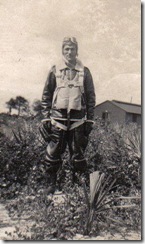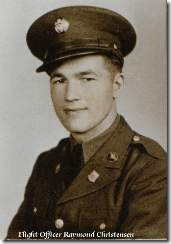
I never met Flight Officer Raymond Christensen personally, but I’ve heard so much about him over the years that it’s hard not to feel close to him. He was my grandfather’s best friend, and my grandmother’s younger brother, although my grandmother never talked about him much. A gifted writer, with devilish good looks, and a sense of adventure, combined with a charming wit all equipped him to make a success of himself in his various undertakings. His life, had it been longer, would have made an incredibly fascinating book.
Growing up in rural Beadle county, South Dakota, my grandparents and their siblings and friends “made their own fun.” They stopped up Cain Creek and made a popular “swimming
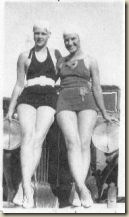 hole”, and occasionally took my grandfather’s old Model A on a road trip. Ray and my grandmother, being less than two years apart, were naturally very close. She was his trusted confidante, and vice versa. But it was his friendship with my grandfather, Bill, that brought out the fun-loving sides of both of them. Bill told how they went to the river and caught snapping turtles, and when they had several of them, they daringly positioned the tail of one in the mouth of another, and so on, until they had a Wagon Train of snappers, all “snapped” together. They then, very carefully, got the first snapper to bite onto a cigarette and clench it between his jagged, razor teeth long enough for a picture to be taken. They learned new and creative ways to shock each other with the aid of an old magneto, an object that kept the boys occupied off and on for years. No one ever truly knew what was safe to sit on, pick up, or even touch with Bill and Ray and that magneto around.
hole”, and occasionally took my grandfather’s old Model A on a road trip. Ray and my grandmother, being less than two years apart, were naturally very close. She was his trusted confidante, and vice versa. But it was his friendship with my grandfather, Bill, that brought out the fun-loving sides of both of them. Bill told how they went to the river and caught snapping turtles, and when they had several of them, they daringly positioned the tail of one in the mouth of another, and so on, until they had a Wagon Train of snappers, all “snapped” together. They then, very carefully, got the first snapper to bite onto a cigarette and clench it between his jagged, razor teeth long enough for a picture to be taken. They learned new and creative ways to shock each other with the aid of an old magneto, an object that kept the boys occupied off and on for years. No one ever truly knew what was safe to sit on, pick up, or even touch with Bill and Ray and that magneto around.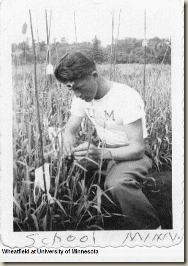
After high school, Ray worked as a farm hand in various midwest locations, until deciding he’d like to go to Agriculture school at the University of Minnesota, a decision that fiercely angered his father. Going it alone, Ray sold life insurance for State Farm in Minneapolis to support himself and pay his tuition. He was the first in his family to pursue higher education. The photo on the left shows him grafting a hybrid wheat plant in the University’s wheat field. His “smarts”, as well as his determination, and his desire for something “bigger”, would have taken him far in the field of agriculture, had he gotten the chance.
World War II altered the course of many lives, and Raymond’s was no exception. After three years of study at the University, he put his agriculture degree on hold and was accepted in an officer’s training school in the Army Air Force. A letter to my grandparents, dated Feb. 20, 1942, reads in part:
“Started to school Saturday and like it O.K. It will come fast but if they keep me in like they have in the past I’ll not only get it, but get fat too. (The) Grub is swell … I’m learning typing – code – electricity and eventually radios. If I pass I may get to be radio man on a bomber and fly all over heck…”
And that’s exactly what happened. After completion of his program, he was assigned to the 417th Night Fighter Squadron as a radar observer with the rank of First Lieutenant. He was one of a crew of two in an English Beaufighter, working with pilot Joseph Leonard. Ray described the relationship between them as such -
“I’ve got quite a bit of faith in my pilot and we get along as well as anybody could … We’ve got to have perfect teamwork to live out this blessed war so we pay as much attention in our teaming up as we would to getting married - probably more. In this case “until death do us part” doesn’t seem to lend any humor to the situation whatever.”
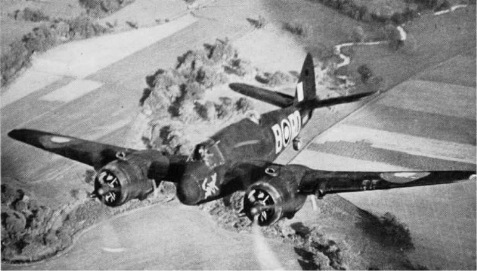
The Bristol Beaufighter
Ray and Joe did well together – a “Stars and Stripes” article gave Flight Officer Raymond Christensen credit for helping to bag a German plane in the North African war zone, in March of 1944. Letters continued to go back and forth between Ray and my grandparents. A letter from Ray, dated May 5, 1944, describes the dangerous situations they faced on the island of Corsica, where Ray was stationed:
“When we go airborne we can look right into Herr Hitler’s back yard and make faces at him. One of his little boys done foxed me the other night so here I sit on the end of the runway just awaitin’ to get revenge…”
This would be the last letter my grandparents got from Ray. Eight days later, he and Joe flew what would be their last mission. The plane was located at the point of the red “X” on the map below, when it was last seen on radar, shortly before going down under enemy fire. Six planes were sent in a search and rescue attempt, joined by six more in the early hours of May 14, my grandmother’s birthday. All they found was “much debris, an oil slick, and two life rafts.”
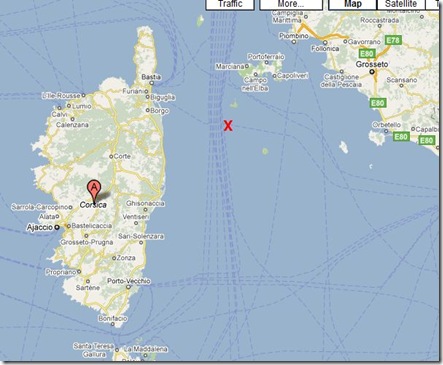
Ray was posthumously awarded the Purple Heart and Air Medal for his courage and sacrifice. And that’s the end of his story. But my mind can’t help but wander, and entertain the notion of what he might have done had he lived a full measure of years. He took life by the horns, and he had some incredible gifts that will go forever unused. We’re left to wonder What If…

